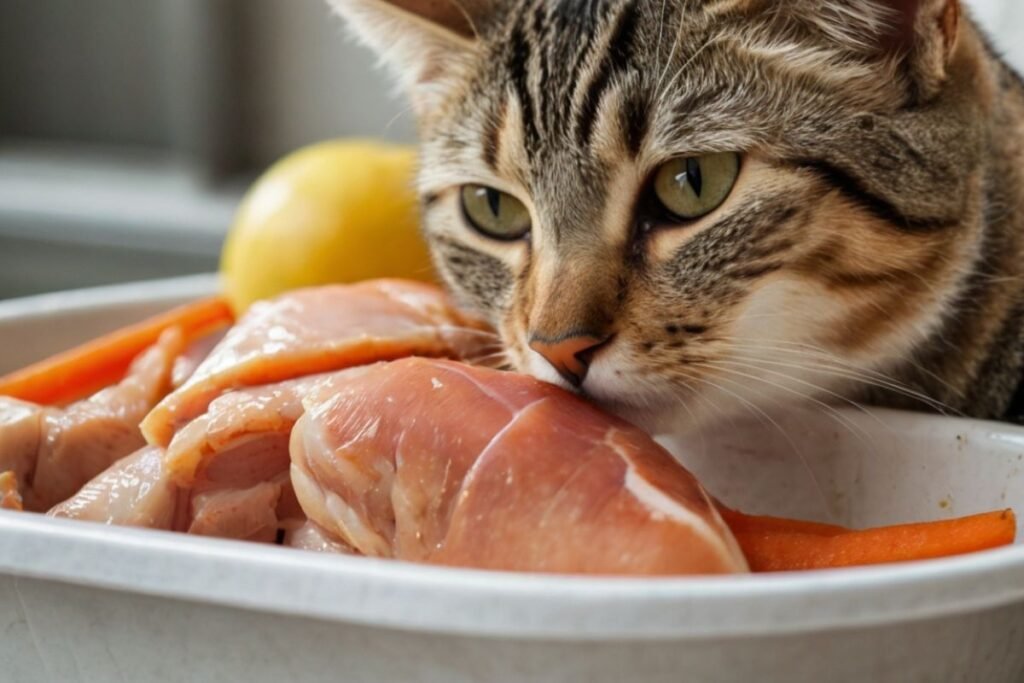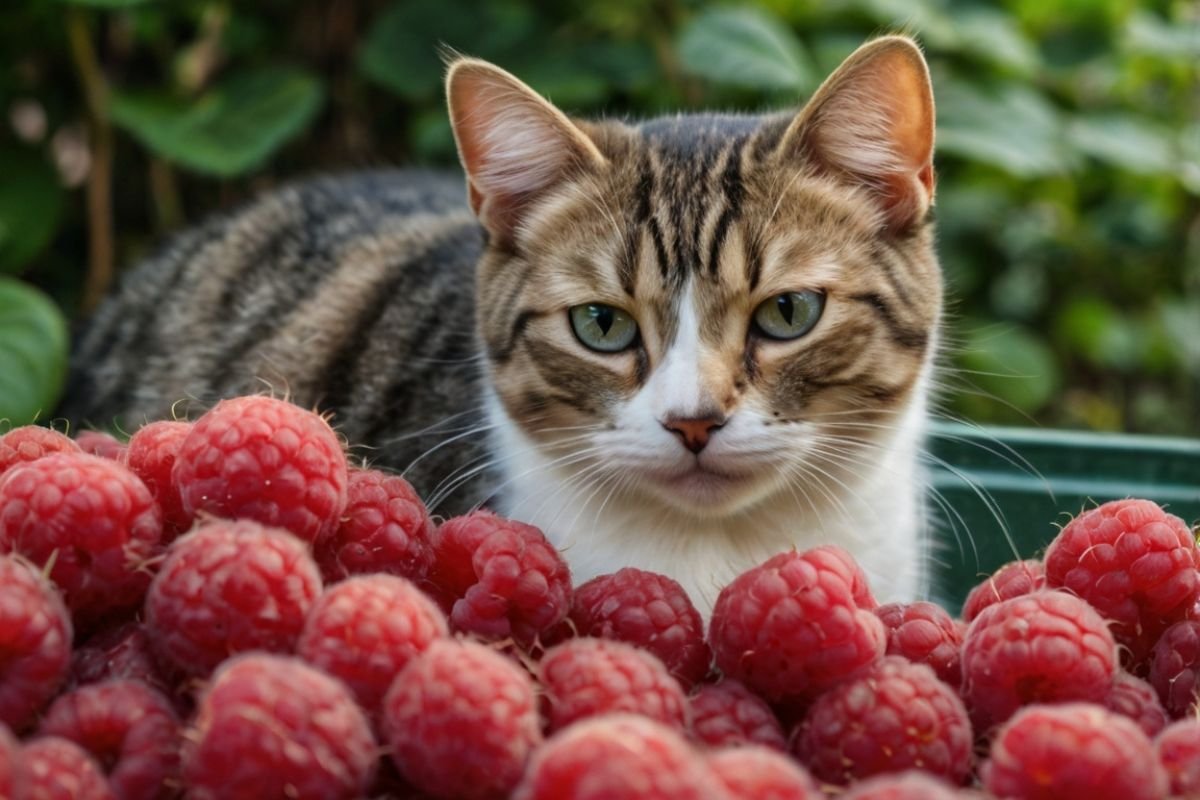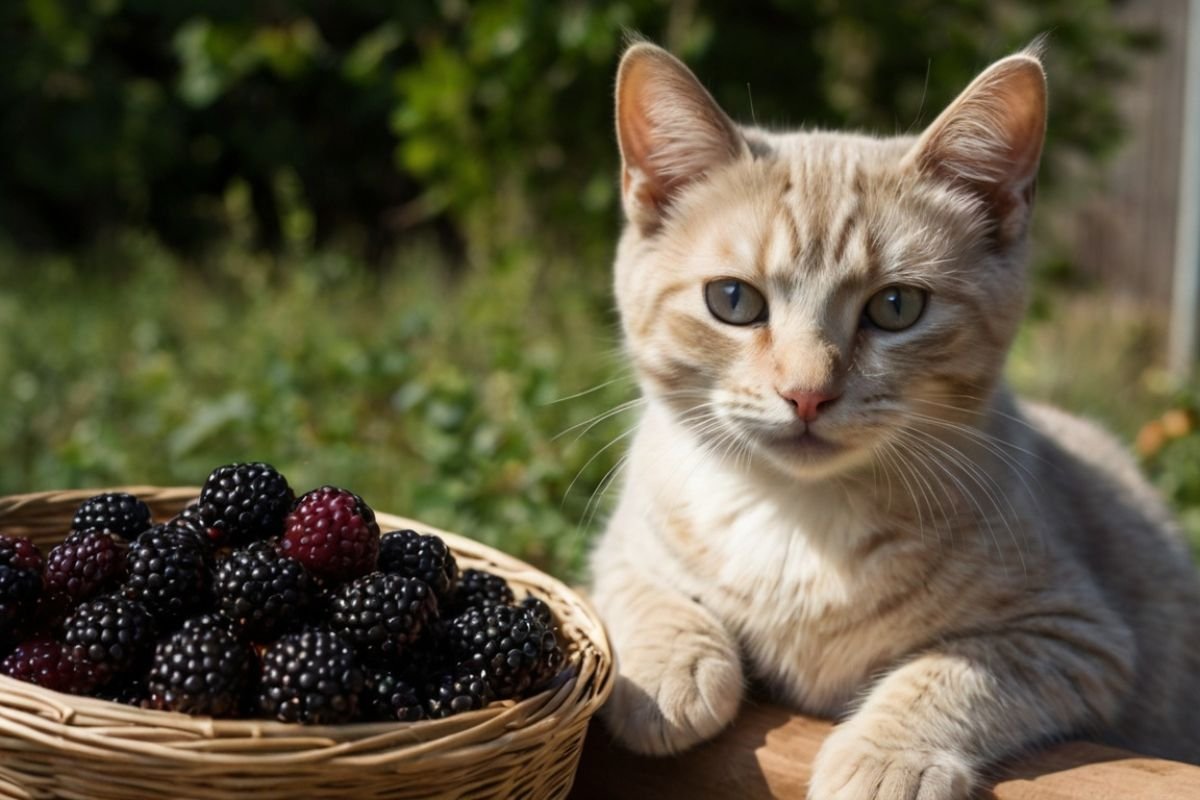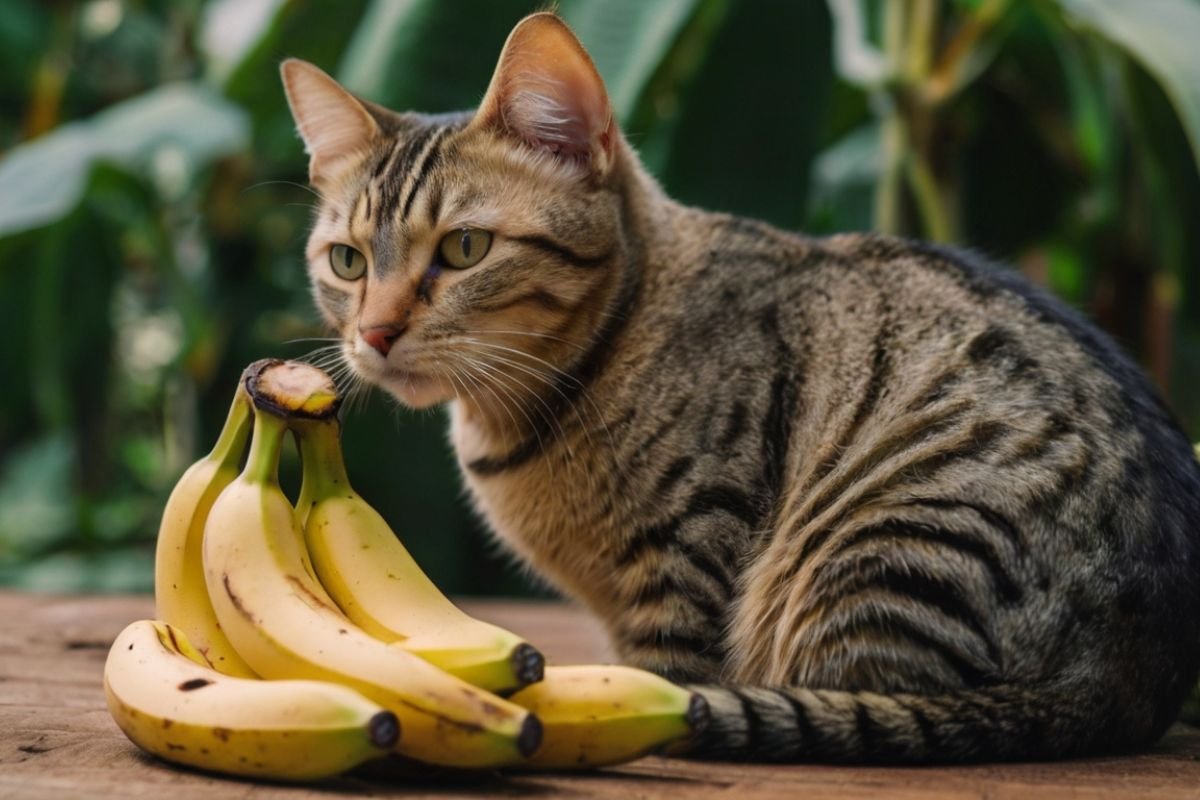The other day, I was preparing chicken for dinner when my orange tabby Rio jumped onto the counter, eyes fixed on the raw meat. His intense stare and gentle paw reaching toward the chicken breast made me wonder – can cats safely eat raw chicken? If you’ve caught your feline friend eyeing your chicken dinner prep with that same longing look, you’re not alone.
Cats are natural hunters. In the wild, their diet consists of prey they catch and eat raw. This might make you think giving your house cat raw chicken is perfectly fine. After all, isn’t it close to what they’d eat in nature? Well, the answer isn’t as simple as a yes or no.
As a cat parent, I’ve learned that what works in the wild doesn’t always translate well to our homes. Our domesticated cats face different health challenges than their wild ancestors. The raw chicken from your grocery store isn’t the same as fresh prey in the wild.
In this guide, I’ll share everything you need to know about cats and raw chicken. We’ll look at the risks, benefits, safety tips, and alternatives. By the end, you’ll have all the facts to make the best choice for your furry friend.
Table of Contents
The Natural Diet of Cats
Cats are obligate carnivores. This fancy term simply means they must eat meat to survive. Their bodies need nutrients found only in animal tissues.
In the wild, cats hunt small prey like mice, birds, and insects. They eat these animals whole – meat, bones, organs and all. This gives them a mix of proteins, fats, vitamins, and minerals they need to stay healthy.
When Rio stares at birds through our window, I’m reminded of his hunting instincts. Even though he’s never had to catch his own dinner, those instincts remain strong.
Domestic cats still have the same basic needs as their wild cousins. But there’s a big difference between prey in the wild and store-bought raw chicken. Wild prey is fresh and free from the kinds of bacteria that can grow on meat from the store.
Can Cats Eat Raw Chicken?

So can your cat eat raw chicken? While cats can technically eat raw chicken, that doesn’t mean they should.
Yes, their digestive systems are built to handle raw meat better than ours. They have shorter digestive tracts and more acidic stomach environments than humans. This helps them process raw meat and kill some harmful bacteria.
But store-bought raw chicken poses risks that wild prey doesn’t. The way chicken is processed, stored, and handled introduces bacteria that can make your cat sick.
If you’re thinking about feeding raw chicken to your cat, you need to weigh the risks and benefits.
Also read, Can Cats Eat Carrots?
Potential Benefits of Raw Chicken for Cats
Some cat owners swear by raw diets. They point to these possible benefits:
- More natural diet: Raw meat is closer to what cats would eat in the wild.
- Dental health: Chewing raw meat and bones may help clean their teeth.
- Better digestion: Some cats digest raw food better than processed cat foods.
- Shinier coat and healthier skin: The natural oils and nutrients in raw meat may improve coat condition.
- Higher energy levels: Some owners report their cats are more active on raw diets.
- Fewer digestive issues: Some cats have fewer hairballs or stomach problems.
- Less smelly litter box: Raw diets can lead to smaller, less smelly stools.
When I first brought Rio home as a kitten, his coat wasn’t as bright orange and glossy as it is now. Good nutrition has made a big difference in his appearance and energy levels.
Risks of Feeding Raw Chicken to Cats
Despite the potential benefits, raw chicken comes with serious risks:
1. Bacterial Contamination
Raw chicken often contains harmful bacteria like:
- Salmonella: Can cause fever, diarrhea, vomiting, and lethargy in cats.
- Campylobacter: May lead to diarrhea and intestinal problems.
- E. coli: Can cause digestive upset and more serious health issues.
- Listeria: Though cats are more resistant than humans, it can still cause illness.
Even though cats have stronger stomach acids than humans, they can still get sick from these bacteria. Young kittens, senior cats, and those with health problems are at even higher risk.
2. Risk to Human Family Members
When you feed your cat raw chicken, you’re not just putting your cat at risk. The bacteria from raw meat can spread in your home. This puts you and your family at risk too, especially:
- Young children
- Elderly family members
- Pregnant women
- People with weakened immune systems
Your cat can spread bacteria by:
- Licking their paws after eating
- Rubbing against surfaces
- Using their litter box
- Licking your face or hands
I notice Rio often grooms himself right after eating. If he’s been eating raw meat, this means he’d be spreading bacteria all over his fur.
3. Nutritional Imbalances
Feeding only raw chicken breast or thighs doesn’t provide all the nutrients your cat needs. Cats require a balanced diet with:
- Various amino acids (like taurine)
- Vitamins
- Minerals
- Fatty acids
In the wild, cats eat the whole prey – including organs, bones, and stomach contents. Just feeding muscle meat can lead to serious nutritional gaps.
4. Choking and Injury Risks
Raw chicken bones can pose risks:
- Small bones can cause choking
- Sharp bone fragments can damage the mouth, throat, or digestive tract
- Bones can get stuck in the intestines
Even though wild cats eat bones, the bones in prey animals are different from the larger, harder bones in store-bought chicken.
5. Parasites
Raw chicken may contain parasites that can infect your cat, such as:
- Toxoplasma gondii
- Various worms
- Other parasitic organisms
These can cause health problems ranging from mild digestive upset to serious illness.
Safe Handling of Raw Chicken for Cats
If you decide to feed your cat raw chicken despite the risks, follow these safety tips:
1. Choose High-Quality Meat
- Buy chicken from trusted sources
- Look for chicken labeled for human consumption
- Consider organic or free-range options
- Fresh is better than frozen when possible
2. Proper Storage
- Keep raw chicken refrigerated until ready to use
- Use within 1-2 days of purchase
- Keep separate from other foods
- Store in sealed containers to prevent juices from leaking
3. Safe Preparation
- Wash hands before and after handling
- Use separate cutting boards for raw meat
- Clean all surfaces that touch raw chicken
- Serve in a clean bowl used only for raw food
- Don’t leave raw chicken out for more than 30 minutes
4. Portion Control
- Feed appropriate amounts based on your cat’s size and weight
- Remove any uneaten portions after 30 minutes
- Start with small amounts to see how your cat tolerates it
5. Balance the Diet
- Don’t feed only chicken breast or thighs
- Include other parts like hearts, livers, and gizzards
- Consider a commercial raw food diet formulated for cats
- Consult with a vet about supplements
Alternatives to Raw Chicken
If you’re worried about the risks of raw chicken, consider these safer options:
1. Cooked Chicken
Cooking chicken kills harmful bacteria while keeping most nutrients. Tips for feeding cooked chicken:
- Remove all bones before cooking
- Don’t use oils, salt, spices, or seasonings
- Boiling or baking without additives is best
- Let it cool completely before serving
- Can be mixed with commercial cat food
When Rio has an upset tummy, plain boiled chicken has been a gentle, protein-rich food that helps him recover.
2. Commercial Raw Cat Food
Commercial raw foods are safer than homemade because they:
- Are tested for bacteria
- Are nutritionally balanced
- Use high-quality ingredients
- Include all needed nutrients
- Follow safety protocols
These come frozen or freeze-dried and have feeding instructions.
3. High-Quality Commercial Cat Foods
Many excellent commercial foods provide the benefits of raw without the risks:
- High-protein, grain-free options
- Limited ingredient diets
- Fresh refrigerated cat foods
- Freeze-dried raw options
- Wet foods with high meat content
These are tested, balanced, and convenient.
4. Home-Cooked Balanced Diet
If you want to make your cat’s food but avoid raw:
- Work with a vet nutritionist to create a balanced recipe
- Include various cooked meats, not just chicken
- Add supplements as recommended
- Follow the recipe exactly
5. Occasional Raw Treats
If you want to offer raw meat sometimes:
- Use it as an occasional treat, not a main diet
- Freeze meat for 3+ days before serving to kill some parasites
- Start with tiny amounts to see how your cat responds
- Follow all safety guidelines for handling
Signs Your Cat May Not Tolerate Raw Chicken
Watch for these signs that raw chicken isn’t agreeing with your cat:
- Vomiting or diarrhea
- Lethargy or weakness
- Loss of appetite
- Behavior changes
- Visible discomfort after eating
If you notice any of these, stop feeding raw chicken and consult your vet.
What Vets Say About Raw Diets
Veterinary opinions on raw diets vary widely:
Many conventional vets discourage raw feeding because of:
- Bacterial risks to cats and humans
- Potential nutritional imbalances
- Lack of scientific evidence supporting benefits
Some holistic vets support carefully planned raw diets because:
- They more closely match cats’ natural diets
- Some cats thrive on them
- They may help certain health conditions
Most agree that if you choose raw feeding:
- Work with a vet knowledgeable about raw diets
- Follow strict food safety protocols
- Ensure the diet is nutritionally complete
- Monitor your cat’s health closely
Special Considerations for Different Cats
Not all cats have the same needs when it comes to diet:
Kittens
Kittens are more vulnerable to:
- Bacterial infections
- Nutritional deficiencies
- Choking hazards
They need perfectly balanced nutrition for growth. Raw diets are generally not recommended unless formulated specifically for kittens.
Senior Cats
Older cats may have:
- Weaker immune systems
- Dental issues that make chewing raw meat difficult
- Kidney or digestive problems that require special diets
Raw food may be too risky for these sensitive seniors.
Cats with Health Conditions
Certain conditions may make raw diets inappropriate:
- Immune disorders
- Cancer (especially during treatment)
- Kidney disease
- Digestive disorders
- Diabetes
Always consult with your vet before changing the diet of a cat with health problems.
Indoor vs. Outdoor Cats
Indoor cats:
- Are less exposed to wild bacteria
- May have more sensitive systems
- Rely entirely on you for proper nutrition
Outdoor cats:
- May already eat raw prey
- Could have stronger immune systems from environmental exposure
- Still need balanced nutrition at home
My Experience with Rio
When Rio was younger, I considered trying raw chicken as part of his diet. After researching and talking with our vet, I decided the risks outweighed the benefits for our household.
Instead, I found a high-quality commercial cat food with chicken as the main ingredient. I occasionally supplement with small amounts of cooked chicken as a treat, which he loves.
What works best varies from cat to cat. Rio has a sensitive stomach, so sudden diet changes upset his system. Your cat might be different.
Frequently Asked Questions About Cats and Raw Chicken

Is raw chicken better than cooked for cats?
Not necessarily. While raw meat has certain enzymes that cooking destroys, cooking eliminates harmful bacteria. The safety benefits of cooking usually outweigh any minor nutritional losses for most house cats.
Can I feed my cat raw chicken necks or wings?
These are risky due to small, sharp bones that can cause choking or internal injuries. If you want to feed parts with bones, grinding them is safer.
How much raw chicken should I feed my cat?
If feeding a balanced raw diet, most cats need about 2-3% of their body weight daily. For a 10-pound cat, that’s about 3-5 ounces per day, divided into two meals.
Can cats get salmonella from raw chicken?
Yes, cats can get salmonella from raw chicken. While they’re more resistant than humans, they’re not immune, especially kittens, seniors, or cats with health issues.
Can I mix raw chicken with commercial cat food?
It’s generally not recommended to mix raw and dry food at the same meal, as they digest at different rates. This can cause digestive upset in some cats.
Do I need to add supplements if I feed raw chicken?
Yes. Raw chicken alone is not nutritionally complete. You’ll need to add organs, bones (ground), and supplements to create a balanced diet.
How do I transition my cat to eating raw chicken?
Start very slowly, mixing tiny amounts with their regular food. Gradually increase the raw portion over several weeks while watching for any negative reactions.
Conclusion
So, can cats eat raw chicken? While they technically can, the risks make it a questionable choice for most house cats and their families.
If you’re drawn to raw feeding because you want your cat to have a natural, high-quality diet, remember there are safer ways to achieve this goal. High-quality commercial foods, occasional cooked chicken treats, or professionally formulated raw diets can provide excellent nutrition with fewer risks.
Whatever you decide, put your cat’s health and safety first. Talk with your vet, do your research, and watch how your cat responds to different foods.
Remember that what works for one cat may not work for another. Rio thrives on his high-quality commercial diet with occasional cooked chicken treats. Your cat might do best with something different.
The most important thing is that you’re taking the time to learn and make informed choices about your cat’s nutrition. That attention and care is what makes you a great cat parent, regardless of what you decide to feed.

Shahriar Robin is the creator of WhatPetsCanEat.com, a passionate pet lover and dedicated cat dad to Rio, a curious two-year-old orange feline who inspired this website. With a love for animals and a knack for research, Shahriar shares trusted, easy-to-understand information to help fellow pet owners make safe, healthy food choices for their furry friends.


